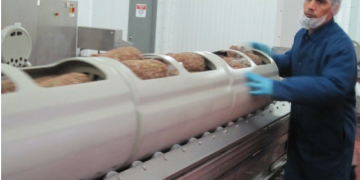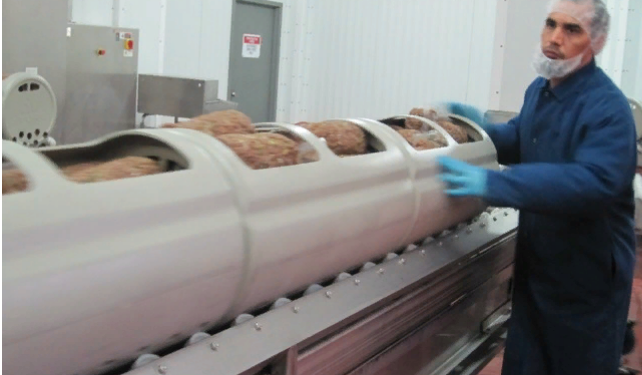High pressure processing, or high hydrostatic pressure processing, is a method of processing fruit products (such as oranges, grapefruits, mangos, etc.), as well as vegetable products, without using added heat.
“It has the potential to produce high-quality, fresh, pure, nutritious, safe-to-consume fruit and vegetable products without using chemical preservatives or artificial additives,” said Samantha Zhang, who works in marketing and product development at All Natural Freshness in White Pigeon, Michigan. “HPP also makes fruit and vegetable products more tolerant to cold chain abuse, further assisting in the minimization of spoilage and associated returns.”
High pressure processing of food involves subjecting fruit and vegetable products to pressures from 400 MPa (58,000 psi) to 600 MPa (87,000 psi) for a period of one to five minutes. These high pressures used in high pressure processing equipment kill most harmful microorganisms, such as salmonella, E. coli and Listeria monocytogenes, by damaging cell components – but unlike ultra high-temperature thermal treatment, HPP does not alter flavor, texture or nutritional value.
“Since high hydrostatic pressure acts quickly and evenly, neither the size of a product’s container nor its thickness plays a role in the effectiveness of HPP. Some juices and beverages may experience a slight change (like the color of strawberries), but HPP helps to substantially maintain nutritional value, taste, texture and appearance,” Zhang said. “As a result, high-pressure treatment of fruit and vegetable products is regarded as a ‘natural’ pressure pasteurization method, as it does not use or rely on any added chemical preservatives.”
Becoming Mainstream
The first commercial products to be used with HPP were guacamole, which is now commonly eaten every week without consumers having to buy fresh avocados to make it.
Lisa Pitzer, marketing director for Avure Technologies in Erlanger, Kentucky, a manufacturer of HPP equipment, said HPP has rapidly become a mainstream food processing method and it’s no longer appropriate to call it a novel technology.
As such, the trend in HPP is to evaluate machinery and projects in normal food technology terms, such as “What is the throughput?” “What is the cost per pound?” “What is the reliability?” and “How much floor space does it occupy?”
“Ten years ago, those questions were about whether HPP would work,” Pitzer said. “Five years ago, the question was could anyone afford it. Now it is accepted and quite common for many foods we eat every day.”
Here’s the way it works: Batches of packaged foods are added to a container called a basket. Multiple baskets are fed into a pressure vessel filled with pure cold water. The pressure is increased to many times the pressure at the deepest point in the ocean, and held there for a few minutes. After treatment, many bacteria cells are no longer able to reproduce and they become incapable of causing disease or spoilage. When done properly, there is no discernible change in the flavor or texture of the food.
Pitzer said HPP is common for juice—fresh tasting juice can’t be heat treated, and untreated juice has a very short shelf life and there is no way to make sure that it is food-safe after processing.
The Latest Trends
Francisco Purroy, technical sales director for Miami, Florida-based Hiperbaric, a manufacturer of HPP equipment for the food industry, said the main drivers of the technology nowadays are the cold-pressed juice category and the HPP tolling (contract service/copacking).
“They are intrinsically linked, as many cold-pressed juice manufacturers are using co-packers for the HPP part of their productions,” he said. “To give an idea about this growth, five years ago there were only a dozen brands making cold-pressed and pressured juices around the globe. By 2012, we had already some 50 customers. Nowadays, we are approaching 150 brands of HPP juice around the world.”
On the machinery front, Hiperbaric has recently launched the largest and most productive cold pressure technology system ever—the Hiperbaric 525, which has helped the company reach more than $30 million in sales.
“Cold pressure technology, or HPP, keeps on being relatively niche, but growing quickly,” Purroy said. “Nowadays, there are almost 300 systems around the world in over 30 countries and all across the spectrum of food and beverage applications.”
Products coming from this method include meat, seafood, salsas, dairy, guacamole, ready-to-eat meals, juices and fruit preps.
“We apply high hydrostatic, isostatic pressure to the packaged products; basically, like putting them very deep into the ocean,” he said. “This pressure transmitted by water is able to kill off microbes while retaining the nutritional and organoleptic properties of the food, respecting the ingredient and its freshness. Shelf life is extended and food safety greatly improved.”
Joyce Longfield, applications and regulatory specialist for Hiperbaric, expects to see even bigger machines for more volume as more HPP tolling facilities become available, some with co-packing options.
“RTE meat and dips and spreads make up approximately 60 percent of the HPP foods in the market. Juice is probably 15 percent, and seafood and dairy make up the rest, with some pharma in there at a very small percentage,” she said. “You have the finished product surrounded by cold water, which builds to 87,000 psi of uniform pressure. The pressure destroys the bacteria and leaves the organoleptic properties and nutrients intact.”
Pitzer said the latest advances in HPP are about the throughput of the machines and the cost per pound.
“It used to be that manufacturers, including Avure, talked about the number of liters of water in the pressure vessel—more water was good,” she said. “Avure is completely focused on the highest throughput, lowest cost to operate and most reliable machines.”
The Final Word
Fresh fruit and produce have some challenges but some tremendous payoffs for the producer (safety and shelf life) and the consumer (taste and preservative free). There are many products on the market and many more being developed.
“Avure has a facility in Ohio staffed by four food scientists who are helping customers formulate and test new products full time,” Pitzer said. “There are many exciting fruit, vegetable and dairy products in addition to meat products of all kinds. Almost all these products are distributed and sold under refrigeration.”
There are numerous advantages of HPP, which include an increased shelf life (three to 10 times longer than the same product without HPP), no impact on sensory, nutritional or functional properties, effective elimination of spoilage and pathogenic microorganisms and greater tolerance to cold chain abuse.
“HPP treatment is capable of rendering fruit and vegetable products that possess quality characteristics similar to those undergoing heat pasteurization or UHT processing,” Zhang said. “However, processing temperature and storage conditions have a significant impact on the final quality of products. High temperature processing can deteriorate sensory (touch, taste and smell) characteristics. Since HPP is a cold temperature process, it enhances shelf life while retaining organoleptic and nutritional qualities, and textures can even be improved in fruit and vegetable products.”


































